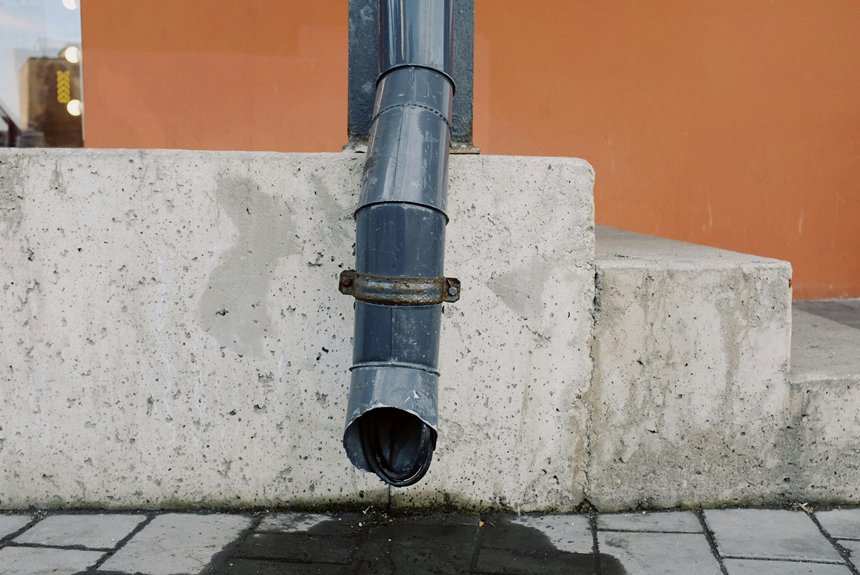When installing an exterior French drain, it’s easy to overlook critical details that can lead to costly failures. Neglecting a proper site assessment or using subpar materials can severely impact drainage effectiveness. Additionally, incorrect slope angles and the absence of filter fabric may result in clogs and water pooling. Understanding these common pitfalls is essential for a successful installation. What other factors should you consider to guarantee long-term performance?
Key Takeaways
- Conduct a thorough site assessment to identify drainage issues and soil conditions before installation.
- Ensure proper slope and drainage angle, aiming for a 1% to 2% gradient to prevent water pooling.
- Use high-quality materials, including gravel and pipes, to enhance drainage efficiency and prevent clogs.
- Install a filter fabric to keep soil and debris out, improving the system’s longevity and performance.
- Establish a regular maintenance schedule to inspect for clogs, sediment buildup, and overall system health.
Neglecting Proper Site Assessment
When you install a French drain, overlooking a thorough site assessment can lead to significant issues down the line.
A detailed site evaluation is essential to identify potential drainage problems and assess the topography. Conducting a soil analysis helps you understand the soil composition, permeability, and water retention capabilities.
A thorough site evaluation and soil analysis are crucial for effective French drain installation and optimal drainage solutions.
These factors influence the effectiveness of your French drain. Without proper evaluation, you might misjudge water flow patterns, leading to inadequate drainage and possible flooding.
By prioritizing site assessment, you guarantee the French drain functions efficiently, minimizing costly repairs and enhancing your landscape’s overall health.
Don’t skip this vital step.
Incorrect Slope and Drainage Angle
When installing a French drain, ensuring the correct slope measurement is essential for effective drainage.
An improper drainage angle can lead to water pooling or inadequate flow, undermining the system’s purpose.
You need to calculate the slope accurately to guarantee ideal performance and longevity of the installation.
Proper Slope Measurement
Although achieving the correct slope is vital for effective drainage, many installers underestimate its importance, leading to significant issues.
A thorough slope assessment is important; a mere one-inch deviation can affect water flow drastically. During your drainage evaluation, verify the slope is consistent, typically around 1% to 2%, directing water towards the designated exit point.
Use a level and measuring tape to confirm accuracy. Remember, an improper slope can result in standing water, increased erosion, and even damage to surrounding structures.
Prioritize precise measurements to maximize the efficiency and longevity of your French drain system.
Drainage Angle Importance
Installing a French drain with the correct drainage angle is crucial, as an incorrect slope can severely undermine the system’s effectiveness. If the angle isn’t right, you risk inadequate water flow, leading to pooling and erosion.
Aim for a slope of at least 1% to enhance drainage efficiency. This slight incline ensures water moves toward the outlet, preventing stagnation.
Additionally, check that the drain’s position aligns with natural terrain contours, maximizing performance.
Using Inadequate Materials
Using inadequate materials can undermine the effectiveness of your French drain system.
By opting for poor quality gravel, ignoring pipe specifications, or skimping on fabric quality, you risk compromising the drainage performance and longevity of the installation.
It’s essential to select the right materials to guarantee proper water flow and prevent future issues.
Choosing Poor Quality Gravel
When you choose poor quality gravel for your French drain installation, you greatly increase the risk of drainage problems down the line. The right gravel types enhance drainage efficiency, while subpar options can lead to clogs and reduced performance.
| Gravel Type | Characteristics |
|---|---|
| Crushed Stone | High drainage efficiency |
| Pea Gravel | Smaller, less effective |
| River Rock | Round, poor filtration |
| Sand | Compacts easily |
| Recycled Material | Variable quality |
Opt for high-quality gravel to maintain peak flow and prevent costly repairs later. Your choice directly impacts the system’s longevity.
Ignoring Pipe Specifications
While it may be tempting to cut costs by selecting inadequate pipe materials for your French drain installation, doing so can lead to significant drainage issues.
Choosing the wrong specifications can compromise your system’s effectiveness. Here are key factors to take into account:
- Pipe diameter: Verify it matches your drainage capacity needs.
- Material strength: Opt for durable materials to withstand soil pressure.
- Joint integrity: Select pipes with reliable connections to prevent leaks.
Ignoring these specifications can result in clogged drains, reduced water flow, and ultimately, costly repairs.
Prioritize quality to guarantee peak drainage performance over time.
Skimping on Fabric Quality
Choosing the right pipe specifications is only part of a successful French drain installation; fabric quality plays a pivotal role as well.
Using inadequate materials can severely compromise fabric durability, leading to premature failure of the system. A high-quality filter fabric guarantees soil particles don’t clog the drainage system, maintaining peak drainage efficiency.
When you skimp on fabric, you risk allowing silt and debris to infiltrate, which can ultimately overwhelm the drainage capacity. Investing in superior fabric materials protects your installation, guaranteeing longevity and effectiveness in managing water flow.
Don’t underestimate the importance of quality in your French drain project.
Failing to Install a Filter Fabric
Neglecting to install a filter fabric in a French drain system can lead to significant issues over time.
Filter fabric serves vital functions that enhance drainage efficiency and longevity. Here are some filter fabric benefits:
- Prevents soil and debris from clogging the drainage system
- Reduces maintenance frequency and long-term costs
- Enhances water flow and drainage performance
Choosing the right filter fabric types, such as woven or non-woven, is essential for best results.
Without proper installation, you risk compromising the entire system’s effectiveness, leading to potential water damage and costly repairs.
Overlooking Maintenance Considerations
If you want your French drain system to function effectively over time, you can’t afford to overlook maintenance considerations.
Establishing a maintenance schedule is essential for guaranteeing ideal performance. Regular inspections help identify clogs, sediment buildup, or damage that could compromise drainage efficiency.
Check for debris accumulation around the drain’s entrance and verify the outlet remains clear. Additionally, inspect the surrounding soil for erosion or settling, which may affect your drain’s effectiveness.
By prioritizing these maintenance tasks, you’ll prolong the lifespan of your French drain system and mitigate potential water damage to your property.
Don’t wait for problems to arise; act proactively.
Ignoring Local Building Codes and Regulations
While it may seem like a minor detail, ignoring local building codes and regulations during French drain installation can lead to significant complications. Compliance not only guarantees safety but also prevents future legal issues.
Here are some reasons to adhere to local regulations:
- Avoid fines: Non-compliance can result in hefty penalties.
- Protect property value: Violations may affect resale potential.
- Guarantee proper drainage: Following codes assures effective water management.
Always consult local building codes before starting your project. This diligence saves you time, money, and headaches down the line, guaranteeing your French drain functions as intended.
Conclusion
To guarantee the effectiveness of your exterior French drain, pay close attention to these common mistakes. Conduct a thorough site assessment, maintain proper slope and drainage angles, and use high-quality materials. Don’t forget to install a filter fabric and commit to regular maintenance. Finally, always check local building codes and regulations. By avoiding these pitfalls, you’ll create a reliable drainage system that protects your property from water damage and enhances its longevity.

